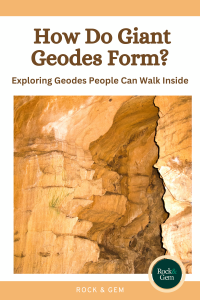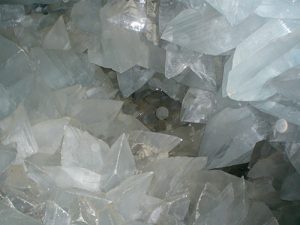
How do geodes form and some get so big? For most of us, a geode we can heft in the palm of a hand is a pretty decent geode. But how about a giant geode that can hold you, and several friends, inside its crystal-lined cavity?

Believe it or not, some geodes grow just that big! Brazilian amethyst vugs the size of small hot tubs have on display at the Quartzsite and Tuscon rock extravaganzas. But these are still babies compared to supersized cavities lined with supersized crystals.
Discovering the Pulpí Geode
One such geode has been dubbed the Geoda de Pulpí or the Pulpí Geode. This “Geoda Gigante” was discovered 165 feet underground in 1999, in an abandoned silver and lead mine in southeastern Spain’s Almería province. At 26 feet long by 6 feet wide by 5.5 feet high, it has been described as about the size and shape of those cement mixer drums mounted on trucks. Its total volume is estimated at 390 cubic feet. Its crystals, composed of ice-clear selenite, average a little over 1.5 feet in length although some are as long as six to seven feet!
Enjoy this popular YouTube video tour of Geoda de Pulpí, which is narrated in Spanish.
In a recent issue of the journal Geology, a team of earth scientists led by Juan Manuel García-Ruiz speculates how this and similar giant geodes grew. In this instance, it involved a cave-sized cavity, a lot of dissolved calcium and sulfate minerals in groundwater, and a long time for crystal growth. The sulfate minerals were likely provided courtesy of an event 5.5 million years ago when the entire Mediterranean Sea dried up.
Understanding Super-Sized Geodes
The big key to super-sized growth was temperature fluctuation related to climate at the time the crystals grew. The researchers have dated the crystal growth to a period two million to 60,000 years ago, or the Pleistocene Ice Ages. This epoch of Earth’s history saw repeated advances and retreats of glaciers as temperatures swung back and forth between icy cold and relative warmth.

There is a process of crystal formation referred to as “cannibal chemistry” or “Ostwald ripening.” In this process, small crystals dissolve and get sucked into ever bigger crystals in solution. Warm temperatures favor the dissolution of smaller crystals whereas chilly temps favor larger crystal growth. Thus the Pleistocene Epoch provided just the right conditions to favor “Ostwald ripening” and the creation of the massive Pulpí Geode.
Other scientists have noted, however, that climate fluctuations above ground may not significantly affect the subterranean environment, which is more likely to be influenced by subsurface hydrothermal activity. Still, climate change could have an effect in that warmer, wetter periods could provide more water to flood into subsurface cavities while colder, drier times would then allow for growth spurts for the selenite crystals.
However it came to be, the Pulpí Geode has surely earned its nickname of “Geoda Gigante”!
This story about super-sized geodes appeared in Rock & Gem magazine. Click here to subscribe Story by Jim Brace-Thompson.













